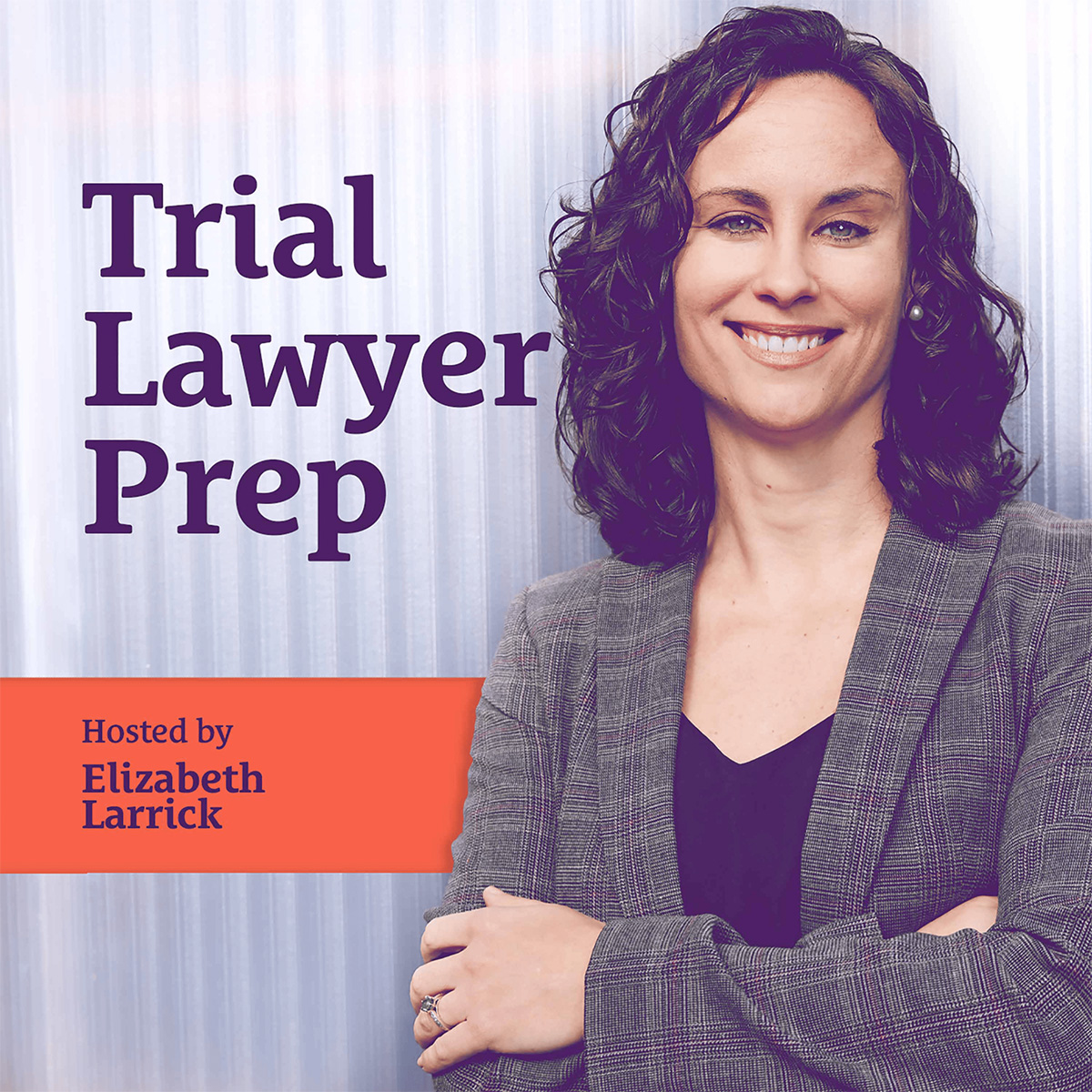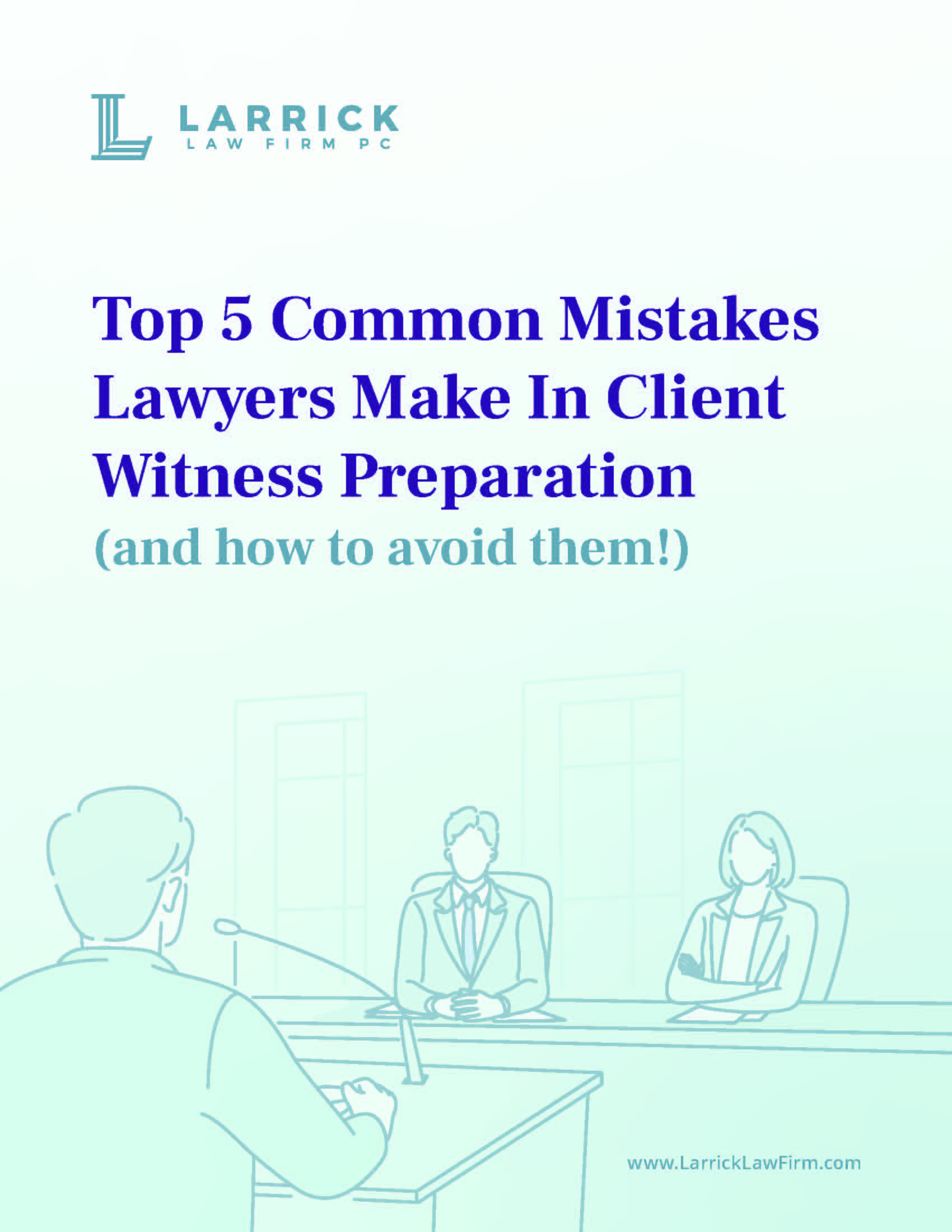Woodshedding Your Client: Negative Impact on the Deposition and Relationship

Have you ever instructed your client to say “I don’t know” when it came to facts or anything that may have been detrimental to your case? Or maybe you’ve been on the other side of that where you were taking a deposition of someone and they just kept on saying they don’t know, just like a broken record.
In this episode, let’s focus on connecting with your client as well as some of those little shortcuts that we take along the way with our clients that could end in a bad result, otherwise known as woodshedding.
Ultimately, woodshedding is disrespectful to your client’s experience and feelings. It can lead to the client losing overall trust in you, as their lawyer, and they may just start lying to you too. So it’s not a very good road to go down.
In this episode, you will hear:
- Where the term “woodshedding” comes from
- Examples of woodshedding
- Why woodshedding is bad
- How to avoid falling into this trap
- Spending time to refresh your client’s memory

Episode Transcript
Hello, and welcome to another new episode of Trial Lawyer Prep with me your host, Elizabeth Larrick.
Thank you so much for joining us. We are going to be talking about wood shedding. This is a podcast designed to assist trial lawyers. [00:01:00] To connect better with their clients and juries in the courtroom. And today we are going to focus on connecting with your client, but also about some of those little shortcuts that we take along the way with our clients that can end in a bad result.
And I am talking about woodshedding. If you’re. Unsure about what wood shedding is. It’s this really old term. It’s also sometimes called horse shedding. Not really sure why that term came up, but it comes from the term Good old days where you’d take somebody out to the woodshed and inflict some punishment on them until they did what you said.
Inflict your will on them. Obviously, I don’t think most attorneys are taking their clients literally out to a woodshed, but the expression is stuck because occasionally we have this behavior. We may run out of time. We may not have the effort or the energy. And so we basically end up [00:02:00] instructing our clients on what to say and also the words to use.
So two of the best examples that I have of woodshedding are instructing a client to say, I don’t know when it comes to questions about facts or liability or something that may be detrimental to your case. We are talking about deposition and even trial. Having your clients basically give testimony that I don’t know to different kind of questions.
And you may have experienced this when you are taking a deposition of someone and basically they’re kind of like a broken record. I don’t know. I don’t remember. I don’t know. I don’t know. And occasionally it’ll be even paired, coupled with an objection from the opposing counsel, which then is a trigger for the client to say, I don’t know.
Very frustrating if you’re on the other side of that, but also let’s not have our clients do [00:03:00] that either. Another good example of woodshedding would be feeding your client the words or the specific answers that you want them to give. For favorable fact questions. And again, we can be talking about liability or damages.
An example that clients involved in a car wreck may not remember, right? The distance from the car in front of them or the exact location of where they are stopped at a red light. But we go ahead and instruct them, Hey, you need to go ahead and answer all the lines of, well, I was stopped where I could see the tires of the car in front of me, or I was stopped behind the white line.
And again, we’re talking about. feeding the answer, right? These are people who have told us, I don’t remember. There are definitely times where people maybe just need to, if there’s a picture, they need to look at a picture or refresh their memory. But we’re talking about really where you are feeding those answers to people.
And again, like we talked about, when does this happen? Well, when we don’t spend enough [00:04:00] time, we don’t take the time. Or, We’re just that worried about the case that we basically end up woodshedding and getting our client to say specific things. So why would this be bad? Obviously we are really bending some ethical rules here.
If we’re instructing our clients with specific answers or to say I don’t know, ultimately it can lead your client to withhold the truth about a situation. Not necessarily meaning if you’re the lawyer, you’re their leader in this legal situation, you’re Asking them to say, I don’t know, or say specific words or responses.
They were probably going to withhold the truth about other stuff too, right? You said it was okay, so they can do it. That’s not really, it’s going to help anybody in the system. It can lead to skewed results. And that’s because sometimes we can obviously see when you’re woodshedding somebody, and then the evaluation that goes back, the way the jury gets the impression, right?
You’re going to lead [00:05:00] to skewed results. It can also just lead to a full disregard of your client’s testimony altogether, right? On all points. That’s not what you want either. Ultimately, it’s really disrespectful to your client’s experience and their feelings, and it can lead to the client losing overall trust in you as their lawyer, and they may just start lying to you too.
So it’s not a very good road to go down. Overall, I think we always want our clients to have a good experience with us as their lawyer, because one, That helps everybody in the legal system. They have a better impression of plaintiff’s lawyers, but also it’s a referral source, but we really don’t want to be bending these rules of ethics just generally.
So how can we try to prevent falling into this trap? We are all very busy people and I’m not trying to say that you are not, but let’s just, first of all, let’s take some [00:06:00] time. Like, set aside some time and listen to the client. Where are there places where there are trouble in the testimony? And are there facts other places?
Are there other people, other witnesses? Are there pictures, right? Is there any way? If there are things written down, can we refresh someone’s memory, right? If it was there one year and two years later it’s gone, but is it written down, right? Go back to your intake forms, go back to those first emails that you got from them when they’re reaching out to your office because generally they put a ton of information in there, right?
So let’s learn what they have, learn their experience, what their testimony is, figure out the troubled spots. Is there a workaround, a way to refresh? Also, Embrace your client’s story, right? Every client narrative is unique and you really want to keep that intact because there could be a juror that that story resonates with.
But if we’re crafting things down to make it sound [00:07:00] identical, everybody knows. It looks like a canned answer. I can tell you from focus groups, they’re like, that’s a canned answer. Like, that’s not the truth. Jurors can spot it. They’re really good at that, right? Spotting the fake. And ultimately, you want to educate your client on how to use the truth, right?
There may be things that your client doesn’t know, will never know, but there’s probably a lot of truth in there that they need to get out. And it’s your job to help them Organize it and know when to use it and deploy it. Nobody’s memory has to be perfect, but we definitely don’t want to be stepping over the line and having them testify to something that’s not true or not to their personal knowledge or something that can’t be refreshed.
You just don’t want to fall into that bad habit. And sometimes that can happen. And you’re thinking, well, Lisbeth, how do I create time in my schedule? Again, we’ve got lots of really good tools in this podcast and [00:08:00] several episodes that can help you with that. But again, Thank you. I, I literally believe that if you spend 30 minutes in the week leading up to your client’s deposition and then you spend another 30 minutes, maybe an hour, you will gain so much more information, right?
We’ve got to pull things out. Most of the time our depositions happen a year, two years after the actual event and you got to refresh the memory and they do too. And they want to do it. So anyhow, it’s spacing it out. Spend some time refreshing it. If you’re going to sit down and get somebody ready for deposition the day before their depo, you’re not giving any time for the memory to be refreshed or for you to go back and look, right, at things that may be available in the file to help with their memory.
Ultimately, we want to avoid this behavior altogether. Embrace what you’ve got, give space and time to listen to them, and if you can, find other things in the file to help them refresh their memory. [00:09:00] But try not to fall into this trap of woodshedding. Use a couple extra meetings even if it’s a 30 minute zoom meeting to plant the seeds and getting back together with them with a couple of days in between will really significantly help refresh their memory.
You’ll have a chance to have looked at the file as well instead of trying to rush through get somebody ready in 30 minutes and the next site they’ve got to then go to deposition when you’re going to learn all kinds of things you’ve never heard before because They thought about all these things in the evening, overnight, and the chemical deposition.
They just dump all this new information. So just a very short, sweet episode here about woodshedding and like, what is it? Why is it bad? And how can we avoid this? Even if we feel like we are super pressured and we don’t have a lot of time. So thank you so much for listening to this episode. I also do some, uh, live broadcasts on my LinkedIn page.
So would [00:10:00] love to connect with you on either one of those platforms. The LinkedIn is Elizabeth J. Larrick. So for more information on tips, I’m doing a ton of stuff this year, particular on virtual focus groups, because I just feel like It’s such a great place thing that we all can be using and can learn how to do it.
And that’s really what I’ve been talking about these past few months. And you can watch all those past videos as well. So if you enjoyed this episode or this podcast, please give us a rating on your favorite platform or share this podcast with another lawyer if you think it’d be helpful. All right.
Thanks so much.